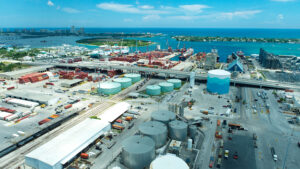Writer: Ryan Gandolfo
 2 min read September 2022 — Ports play an integral role in the regional economy and can set a strong foundation for future growth. As the Port of Palm Beach inches closer to implementing its 20-year strategic plan, the way ports operate will look plenty different by 2040.
2 min read September 2022 — Ports play an integral role in the regional economy and can set a strong foundation for future growth. As the Port of Palm Beach inches closer to implementing its 20-year strategic plan, the way ports operate will look plenty different by 2040.
“Because we are landlocked and only have 165 acres compared to ports with thousands, we must do a lot with what we have. But the port is also one of the most efficient, processing over $14 billion in commodities, 2.5 million tons of cargo and welcoming half a million cruise passengers each year,” Port of Palm Beach Executive Director Manuel Almira told Invest:.
According to Almira, the Riviera Beach-based seaport has more than 30 tenants and employs nearly 3,000 people — in addition to contributing over $304 million in business revenue to the local economy. Among Florida’s 14 deepwater ports, it is the fourth-busiest container port.
Included in the draft plan is a priority to increase rail capacity to best utilize the port’s 165 acres of land, a significant contrast to Port Tampa’s 1,000 acres of industrially zoned land.
“We aim to double our rail capacity since we serve as a major transit point for billions of dollars of goods each year. Given current traffic issues and an increasing population, trucking will eventually come to a standstill in Florida. We particularly see challenges along the interstate and turnpike,” said Almira. “The only alternative I see is rail and doubling our capacity provides a solution for the future. The expansion of the rail infrastructure could eliminate up to 29,000 truck trips per year from the l-95.”
The port recently received $13 million in Department of Transportation funding as part of a $26 million Port Infrastructure Development (PID) grant. The other half is a matched contribution from the port and the private sector. The funding will help increase the port’s rail freight capacity to 95,000 containers.
Another area of emphasis is security. The global maritime port security market is forecasted to reach $9.10 billion by 2030, with cybersecurity among the key technologies slated to generate the highest revenue.
“Ports remain a major safety concern as a critical component of global supply chains and commerce. Any disruption at ports would affect the interconnected transportation, energy production, and manufacturing industries and have far-reaching economic consequences across a country or even a larger region,” said Frost & Sullivan Industry Analyst Aravind Srimoolanathan.
“We must be on top of the latest technological advances when it comes to security since it evolves on a week-by-week basis. The port is extremely secure, but we are always looking for ways to upgrade our systems. Because we are always monitoring safety, we are able to keep up to date with the latest developments, but it takes dedicated time and effort,” Almira told Invest:.
One of the biggest questions that remain for the port and surrounding coastal areas is environmental changes.
“We really all must be on the same page when it comes to avoiding natural disasters, especially in communities in Florida that are vulnerable to the impacts of climate change. We cannot work in silos. We can make all the plans we want to raise sea walls within our own communities, but we are only as effective as our neighbors,” said Almira. “Working together is the best way to make these decisions and investments.”
For more information, please visit:

